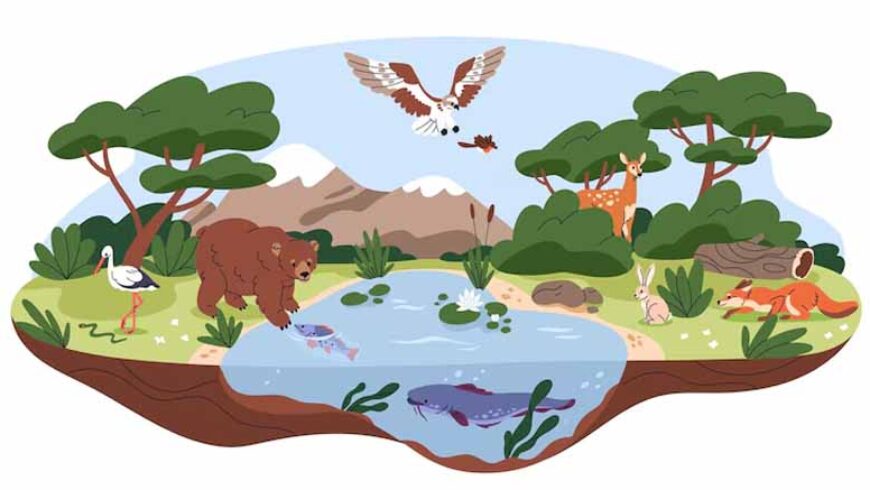Understanding the animal habitats is a topic that can engage children and peak their curiosity. These animal homes, called habitats, play a vital role in the survival and health of numerous species. Let us dive deep into the various kinds of animals and their habitats, the materials used in their construction, and the importance of these homes.
Animals and their Habitats
There are numerous animal habitats existing in nearly every environment on our planet. Whether in forests or dry deserts, each ecosystem has distinct challenges and advantages for its species. Gaining insight into these habitats enhances the understanding of ecosystem complexity and the adaptation of wildlife with those environmental conditions.
Animal Homes – Names
- Nests
- Birds: Birds are widely recognized as best nest builders. They use materials such as twigs, leaves, feathers, and occasionally mud to construct secure environments for their eggs and young. Various species of birds exhibit distinct nesting behaviours. For instance, eagles construct considerably strong and large nests on the top of the trees or on cliffs. Whereas hummingbirds build small, complex nests from spider silk and plant fibres.
- Insects: Certain insects, such as wasps and bees, create nests. Bees make hives from wax, which act as their homes and storage for honey. Wasps, in contrast, use chewed wood fibres to form nests that resemble paper.
- Burrows
- Mammals: Various mammals like rabbits, foxes, and meerkats create burrows for their homes. These underground spaces keep them safe from predators and harsh weather. Burrows can be basic or complex, featuring several rooms and tunnels.
- Reptiles: Some reptiles, such as tortoises and some lizards, use burrows. These homes help them control their body heat and stay safe from predators.
- Dens
- Large Mammals: Animals such as bears and wolves have dens. Bears usually sleep through the winter in their dens, while wolves use them to care for their young. Dens are often found in quiet places like caves, hollow trees, or holes in the ground.
- Webs
- Spiders: Spiders are well-known for their complex webs, which act as both shelters and tools for catching prey. Various spider species build different kinds of webs, including the traditional orb webs, funnel webs, and sheet webs.
- Hives
- Bees: Bees create hives from wax. These hives serve as homes, food storage, and nurseries for their young. The hexagonal shape of the cells is a great example of nature’s design, offering strong support while using little material.
- Coral Reefs
- Marine Life: Coral reefs are lively underwater communities created by small coral polyps. They offer shelter to many types of sea creatures, such as fish, crabs, and snails. Coral reefs are crucial for the well-being of the ocean environment.
Materials Used in Building Animal Homes
Animals build their homes using different materials. They usually pick items that are found around them. Here are some typical materials.
- Twigs and Leaves: Birds and small mammals often use twigs and leaves to build nests and burrows. These materials are lightweight and easy to mold.
- Mud: Some birds, like swallows, use mud to build their nests. Mud provides a sturdy and durable building material.
- Wax: Bees produce wax from glands on their bodies to construct their hives. Wax is flexible and can be moulded into the hexagonal cells of the hive.
- Silk: Spiders produce silk from specialised glands to spin their webs. Silk is incredibly strong and can be used to create intricate structures.
- Wood Fibres: Wasps chew wood fibres to create a paper-like substance for their nests. This material is lightweight and easy to shape.
Animal habitats- Importance
- Protection: Homes provide animals with protection from predators and harsh weather conditions. For example, burrows and dens offer a safe retreat from the elements and potential threats.
- Reproduction: Many animals use their homes as places to lay eggs and raise their young. Nests, dens, and hives provide a secure environment for offspring to grow and develop.
- Food Storage: Some animal homes, like beehives and squirrel nests, are also used to store food. This ensures that the animals have a reliable food source during times of scarcity.
- Temperature Regulation: Homes can help animals regulate their body temperature. For example, burrows provide a cool refuge during hot weather and warmth during cold weather.
Fun Activities to Learn About Animal Homes
Engaging in hands-on activities can make learning about animal homes even more exciting for kids. Here are a few ideas:
- Build a Birdhouse:
- Create a Spider Web:
- Visit a Zoo or Nature Reserve:
- Read Books and Watch Videos:
Kids can build and decorate their own birdhouses. This activity teaches them about the materials and construction techniques birds use to build their nests.
Using string and glue, kids can create their own spider webs. This activity helps them understand the structure and function of spider webs.
Observing animals in their natural habitats or in well-designed enclosures can provide valuable insights into how animals live and interact with their environment.
There are many educational books and videos available that explore the topic of animal homes. These resources can provide additional information and spark further curiosity.
Conclusion
Understanding animal habitat is an exciting and informative adventure that can spark a lasting curiosity for nature and wildlife. When kids learn how different animals create and use their homes, they gain a greater appreciation for the natural world. There are many ways to dive into this interesting subject from reading books to doing activities and even watching animals.
Teachers at Mother’s Pet Kindergarten help children explore animal homes to not only boost their knowledge but also help them develop a sense of curiosity and respect for the environment.













Recent Comments